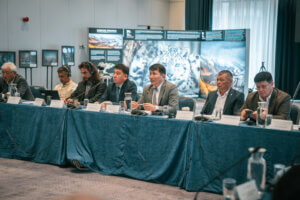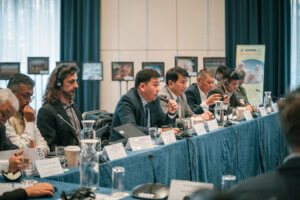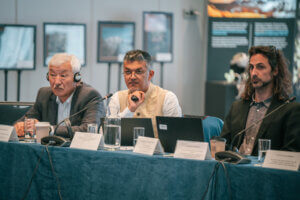The National Consultation Meeting of the United Nations Environment Programme (UNEP) Vanishing Treasures Programme was held in Bishkek. The event marked the presentation of the final report on the successful completion of the international Vanishing Treasures Programme of UNEP and its partners in Kyrgyzstan. The meeting was attended by representatives of various government agencies, beneficiaries of the UNEP Vanishing Treasures Programme, including the Secretariat of the Global Snow Leopard and Ecosystem Programme (GSLEP), the Ilbirs Foundation, the Snow Leopard Trust (SLT) and the Snow Leopard Foundation in Kyrgyzstan (SLFK).
Kumar Mambetaliev, the Director of the Bioresources Department at the Ministry of Natural Resources, Ecology, and Technical Supervision of the Kyrgyz Republic, highlighted the global challenges in conserving the snow leopard and its ecosystems in his address. He underscored the undeniable link between the conservation of the snow leopard, environmental protection, climate change, and sustainable development goals. Recognizing the critical importance of preserving the snow leopard and its ecosystems, the President of the Kyrgyz Republic, S. Zhaparov, signed a Presidential Decree declaring the snow leopard as a national symbol of the Kyrgyz Republic.
Over the past five years, UNEP’s “Vanishing Treasures” program has been diligently working with local communities in the project areas to enhance the survival conditions of the snow leopard, the national symbol of the Kyrgyz Republic. The program has made significant strides in providing sustainable alternative livelihoods, such as beekeeping, small fruit plantations, and ecotourism, to the local residents of the snow leopard ecosystem, thereby reducing negative environmental impacts.
Key projects executed in Suusamyr, Toktogul, Chon-Kemin, Kochkor, Shamshy, and Ak-Suu have been designed to alleviate human-wildlife conflicts and generate economic opportunities for local communities, all while safeguarding the fragile snow leopard ecosystem. The meeting also served as a platform to discuss future prospects for continuing conservation activities and broadening cooperation in the protection of endangered mountain species.
Vanishing Treasures Project: Summary
The Vanishing Treasures project tackles the dual threats of biodiversity loss and climate change by focusing on the conservation of three iconic mountain species: snow leopards in Central Asia, Royal Bengal tigers in Bhutan, and mountain gorillas in the Virungas. By protecting these flagship species, the project aims to conserve entire mountain ecosystems and empower local communities. The project operates in three pilot regions (Central Asia, the Virungas, and Bhutan) and utilizes a similar approach tailored to each location: understanding the impact of climate change on both species and communities, mitigating human-wildlife conflict, and implementing adaptation strategies to build resilience. This knowledge is then used to collaborate with stakeholders and implement on-the-ground solutions like ecosystem-based adaptation measures and alternative livelihood options. By sharing its findings and experiences, the Vanishing Treasures project aims to influence global policy changes for the benefit of mountain biodiversity worldwide.
The Vanishing Treasures Project’s component being implemented in the Kyrgyz Ala-Too mountains aims to restore snow leopard populations and create resilient ecosystems alongside local communities. Here’s a brief summary of the project’s activities:
Landscape Assessment:
- Snow leopard density, estimated at 0.29 per 100 sq km, indicates potential for significant population growth.
- Protected areas and steeper slopes harbor higher snow leopard densities, highlighting their importance, but also underscoring the potential of areas outside conventional protection regimes.
- Prey abundance and future distribution were assessed under various climate change scenarios until 2050.
- Recolonization of argali populations (locally extinct since 1990s) was observed, showcasing habitat restoration potential.
- Marmot and vegetation surveys were conducted using drones and AI, providing valuable ecological data on the distribution of this seasonally available prey species.
- Socio-economic profiles of 30+ villages were gathered, understanding community needs and potential.
- Stakeholder analysis identified groups most impacted by climate change and ecosystem services.
- Climate projections and risk assessments were conducted for six pilot communities. Based on socio-demographic profile, livelihood, health, social networks, finance, food, water, natural disasters and climate variability, and human wildlife interactions, Sussamyr had the highest LVI (0.41), indicating that it was the most at risk, and Chon-kemin had the least (0.36), indicating that it was the leastat risk. The rest in the decreasing order of LVI are Shamshy (0.41), Kochkor (0.37), Bel-Aldy (0.37), andAksuu (0.37).
Interventions:
- Collaborative consultations with local communities identified and prioritized interventions.
- Cost-benefit analyses ensured feasibility and effectiveness of chosen initiatives.
- Conservation contracts were signed, formalizing community engagement in biodiversity conservation.
- Implemented initiatives include:
- Honey production and nature-based tourism for income diversification.
- Fruit tree plantations to improve livelihoods and habitat quality.
- Livestock vaccination facilities to minimize disease outbreaks.
- Community-owned conservancy for enhanced management outside conventional PAs.
- Decentralized water systems such as rainwater harvesting tanks and drip-irrigation systems to provide water for plantations and build climate resilience.
- Continuous monitoring and evaluation are conducted for course correction as needed.
Policy and Knowledge Sharing:
- Supported the Global Snow Leopard & Ecosystem Protection Program in policy development and multi-country collaboration.
- Conducted media training to enhance communication on biodiversity and climate change.
- Organized exposure visits for policymakers (Vice Minister and Member of Parliament) to understand the complexities and opportunities of nature-based tourism and artificial glaciers.
- Facilitated beekeeper exchange programs to access national and international markets.
- Conducted economic analyses to assess the value addition of project initiatives under climate change scenarios.
- Developed a climate-smart management plan for the Ala-Too landscape.
- Published and disseminated knowledge through the “Equal One” program, promoting sustainable economies in snow leopard landscapes.
This project presents a successful model of integrated research, community-based conservation and policy based scaling up towards fostering a future where snow leopards and biodiversity thrive alongside climate resilient communities.
Notes: Vanishing Treasures Project in Kyrgyzstan










